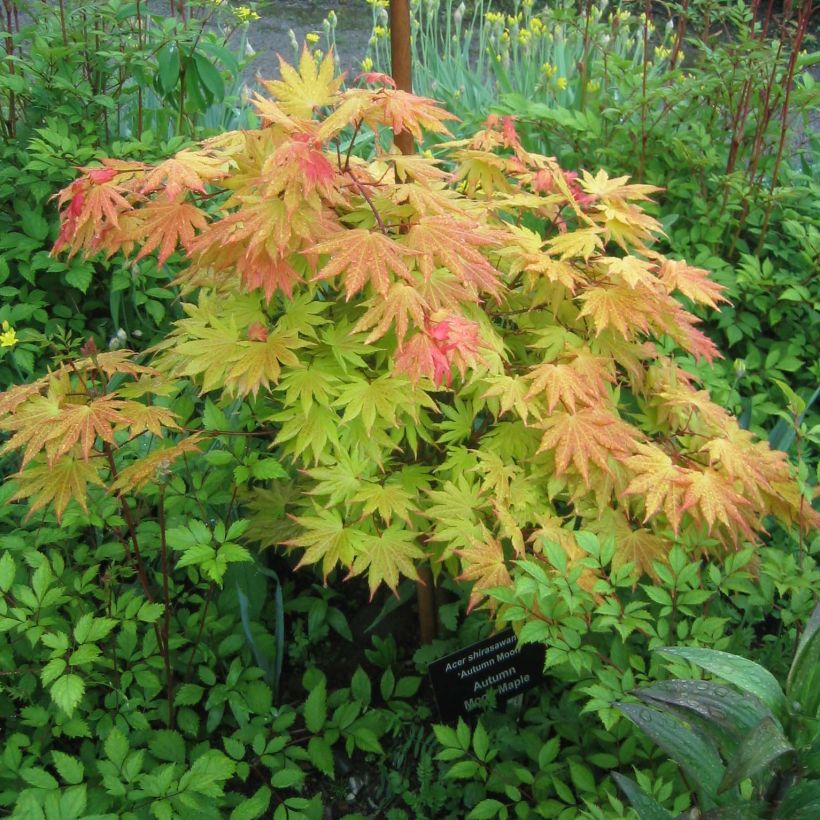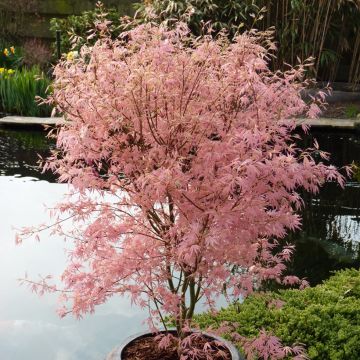

Acer shirasawanum Autumn moon - Japanese Maple


Acer shirasawanum Autumn moon - Japanese Maple
Acer shirasawanum Autumn moon - Japanese Maple
Acer shirasawanum Autumn moon
Golden full moon maple, Shirasawa maple, Japanese maple
I planted one five years ago. It is truly magnificent, I have three other varieties, but I am amazed by the changing colours of the leaves: pink in spring, then golden and green leaves in summer, and a beautiful golden hue in autumn. The shape of the leaf is very pretty.
Robert, 13/01/2020
This item cannot be shipped to the selected country
Delivery charge from €5.90
Delivery to Corse prohibited
More information
Schedule delivery date,
and select date in basket
This plant carries a 24 months recovery warranty
More information
We guarantee the quality of our plants for a full growing cycle, and will replace at our expense any plant that fails to recover under normal climatic and planting conditions.
From €5.90 for pickup delivery and €6.90 for home delivery
Express home delivery from €8.90.
Delivery to Corse prohibited: UE law prohibits the import of this plant from mainland France to Corse as part of the fight against Xylella fastidiosa. Please accept our sincere apologies.
More information

Does this plant fit my garden?
Set up your Plantfit profile →
Description
Acer shirasawanum 'Autumn Moon' is a unique variety of Japanese maple with sumptuous autumn foliage turning pink, and curiously rounded fan-shaped leaves. This small tree, with a natural habit, produces young spring foliage in soft orange-pink tones that turns chartreuse green to very bright light green in summer. The green gradually becomes tinged by more orange tones at the end of summer, ending up pink in October. Its growth is very slow, and it often forms multiple trunks, highlighting the splendour of the foliage with its admirable habit. To fully enjoy the spectacle of its metamorphosis, place it near the house or in a large container on a terrace. It is superb as a standalone in a small garden, with a Japanese or Zen, exotic or contemporary style.
Like all maples, it belongs to the Sapindaceae family (formerly Aceraceae). Acer shirasawanum, from which it originates, is a distinct species of Japanese maple from Acer palmatum. It is particularly native to the mountains of Honshu and Shikoku. It is beautifully called "Full moon maple" due to the rounded shape of its leaves and their particularly luminous appearance. This slow-growing tree can reach a height of 15m (49ft) in nature and is the origin of some very beautiful varieties such as the 'aureum' forms from which 'Autumn Moon' descends.
'Autumn Moon' is a hardy small tree, which tolerates small amounts of limestone in the soil. Over time, it develops a bushy and rounded habit, almost as wide as it is tall. It will reach a height of about 3m (10ft) and a spread of 2.5m (8ft) at maturity. Its almost horizontal branches develop magnificent deciduous circular leaves, which can measure up to 15cm (6in) in length and 10cm (4in) in width. They are borne on red petioles and their edges are divided into 7 to 13 lobes. The colouration of the foliage is determined by sun exposure: a bright exposure is necessary, but scorching sun should be avoided. Discreet flowering takes place in April-May, depending on the climate. The yellow-green flowers, grouped in small upright clusters, produce fruits with curved wings, called samaras. The fruits are initially green before turning carmine red when ripe. This variety has smooth, grey-brown bark.
'Autumn Moon' grows best in preferably neutral to slightly acidic, cool, fertile, loose and well-drained soil, in a semi-shaded position sheltered from cold and dry winds. Compact but sculptural, it is suitable for small gardens, for ornamenting terraces and patios, as well as for large shaded rockeries. Azaleas, pieris, rhododendrons, wild camellias, and heathers will be its most beautiful companions. Combine several varieties of Japanese maple to vary the colours and structures of the foliage; the effect is always dazzling at the end of the season. Its foliage deserves to be accompanied by shades of purple that beautifully enhance it from spring to autumn: for example, choose physocarpus, dark berberis, or a purple hazel for a dazzling scene.
Report an error about the product description
Acer shirasawanum Autumn moon - Japanese Maple in pictures




Plant habit
Flowering
Foliage
Botanical data
Acer
shirasawanum
Autumn moon
Aceraceae
Golden full moon maple, Shirasawa maple, Japanese maple
Cultivar or hybrid
Other Japanese Maples
Planting and care
Plant in spring or autumn in preferably light, slightly acidic to neutral, deep, loose and well-drained soil, in a semi-shaded or shaded position, sheltered from cold and dry winds. The soil should be kept moist by mulching in summer, if necessary, but should not be waterlogged in winter. Apply a significant amount of organic matter every 3 years to ensure a good humus content in the soil. Mulch if necessary, and water and mist the foliage on hot evenings. Winter pruning is limited to balancing the branches. Treat preventively against scale insects and Verticillium, a fungal disease that occurs in heavy and overly moist soil.
Planting period
Intended location
Care
-
, onOrder confirmed
Reply from on Promesse de fleurs
Striking foliage shrubs
Haven't found what you were looking for?
Hardiness is the lowest winter temperature a plant can endure without suffering serious damage or even dying. However, hardiness is affected by location (a sheltered area, such as a patio), protection (winter cover) and soil type (hardiness is improved by well-drained soil).

Photo Sharing Terms & Conditions
In order to encourage gardeners to interact and share their experiences, Promesse de fleurs offers various media enabling content to be uploaded onto its Site - in particular via the ‘Photo sharing’ module.
The User agrees to refrain from:
- Posting any content that is illegal, prejudicial, insulting, racist, inciteful to hatred, revisionist, contrary to public decency, that infringes on privacy or on the privacy rights of third parties, in particular the publicity rights of persons and goods, intellectual property rights, or the right to privacy.
- Submitting content on behalf of a third party;
- Impersonate the identity of a third party and/or publish any personal information about a third party;
In general, the User undertakes to refrain from any unethical behaviour.
All Content (in particular text, comments, files, images, photos, videos, creative works, etc.), which may be subject to property or intellectual property rights, image or other private rights, shall remain the property of the User, subject to the limited rights granted by the terms of the licence granted by Promesse de fleurs as stated below. Users are at liberty to publish or not to publish such Content on the Site, notably via the ‘Photo Sharing’ facility, and accept that this Content shall be made public and freely accessible, notably on the Internet.
Users further acknowledge, undertake to have ,and guarantee that they hold all necessary rights and permissions to publish such material on the Site, in particular with regard to the legislation in force pertaining to any privacy, property, intellectual property, image, or contractual rights, or rights of any other nature. By publishing such Content on the Site, Users acknowledge accepting full liability as publishers of the Content within the meaning of the law, and grant Promesse de fleurs, free of charge, an inclusive, worldwide licence for the said Content for the entire duration of its publication, including all reproduction, representation, up/downloading, displaying, performing, transmission, and storage rights.
Users also grant permission for their name to be linked to the Content and accept that this link may not always be made available.
By engaging in posting material, Users consent to their Content becoming automatically accessible on the Internet, in particular on other sites and/or blogs and/or web pages of the Promesse de fleurs site, including in particular social pages and the Promesse de fleurs catalogue.
Users may secure the removal of entrusted content free of charge by issuing a simple request via our contact form.
The flowering period indicated on our website applies to countries and regions located in USDA zone 8 (France, the United Kingdom, Ireland, the Netherlands, etc.)
It will vary according to where you live:
- In zones 9 to 10 (Italy, Spain, Greece, etc.), flowering will occur about 2 to 4 weeks earlier.
- In zones 6 to 7 (Germany, Poland, Slovenia, and lower mountainous regions), flowering will be delayed by 2 to 3 weeks.
- In zone 5 (Central Europe, Scandinavia), blooming will be delayed by 3 to 5 weeks.
In temperate climates, pruning of spring-flowering shrubs (forsythia, spireas, etc.) should be done just after flowering.
Pruning of summer-flowering shrubs (Indian Lilac, Perovskia, etc.) can be done in winter or spring.
In cold regions as well as with frost-sensitive plants, avoid pruning too early when severe frosts may still occur.
The planting period indicated on our website applies to countries and regions located in USDA zone 8 (France, United Kingdom, Ireland, Netherlands).
It will vary according to where you live:
- In Mediterranean zones (Marseille, Madrid, Milan, etc.), autumn and winter are the best planting periods.
- In continental zones (Strasbourg, Munich, Vienna, etc.), delay planting by 2 to 3 weeks in spring and bring it forward by 2 to 4 weeks in autumn.
- In mountainous regions (the Alps, Pyrenees, Carpathians, etc.), it is best to plant in late spring (May-June) or late summer (August-September).
The harvesting period indicated on our website applies to countries and regions in USDA zone 8 (France, England, Ireland, the Netherlands).
In colder areas (Scandinavia, Poland, Austria...) fruit and vegetable harvests are likely to be delayed by 3-4 weeks.
In warmer areas (Italy, Spain, Greece, etc.), harvesting will probably take place earlier, depending on weather conditions.
The sowing periods indicated on our website apply to countries and regions within USDA Zone 8 (France, UK, Ireland, Netherlands).
In colder areas (Scandinavia, Poland, Austria...), delay any outdoor sowing by 3-4 weeks, or sow under glass.
In warmer climes (Italy, Spain, Greece, etc.), bring outdoor sowing forward by a few weeks.






















































